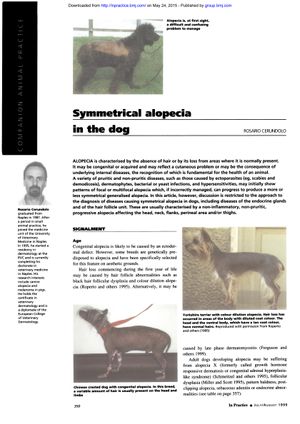Symmetrical alopecia in the dog
July 1999
in “In Practice”

TLDR The conclusion is that a systematic approach is key for treating symmetrical alopecia in dogs, but treatment may not always be necessary.
The document from 1999 reviews the diagnosis and treatment of symmetrical alopecia in dogs, a condition characterized by non-inflammatory, non-pruritic, progressive hair loss. It emphasizes the need to consider factors such as age, breed, coat color, and sex in diagnosis, as these can influence the likelihood of certain alopecic conditions. The paper outlines a clinical approach to diagnosis, including physical and dermatological examinations and various tests such as coat brushing, cytology, skin scrapings, and trichogram analysis. It also discusses the use of blood and urine analysis, hormonal tests, radiographs, ultrasound, and skin biopsy to identify underlying causes, which can range from endocrine disorders to genetic conditions. Treatments vary depending on the diagnosis and may include hormonal supplementation or surgical intervention. However, some forms of alopecia, like seasonal flank alopecia and color dilution alopecia, may not require treatment if they are purely aesthetic. The paper concludes that a systematic approach is essential for treatment and prognosis, but also notes that alopecia is not life-threatening and may not always necessitate treatment.
View this study on bvajournals.onlinelibrary.wiley.com →